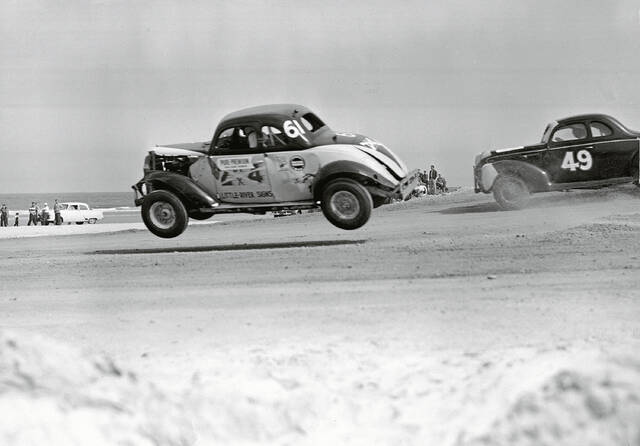NASCAR 75: Car evolution includes stock, wings, safety. Could EV be next?
DAYTONA BEACH, Fla. — NASCAR’s next 75 years almost certainly will include at least a partially electric vehicle turning laps at Daytona International Speedway.
It’s unfathomable to some, unconscionable to others.
It’s unlikely the sanctioning body would make the transition without at least trying to keep the heart-pounding sound of a throaty engine and the permeating smell of exhaust fumes.
“Do I see us racing EVs down the road? Probably,” former NASCAR crew chief and longtime Fox Sports commentator Larry McReynolds said. “But I’m going to be very honest and very candid. I hope it’s after I’ve left the sport. I like what we’ve got.”
Even though the Next Gen car is entering its second NASCAR season — and already has been tweaked in hopes of preventing more head injuries such as the one that sidelined 2004 champion Kurt Busch indefinitely — the evolution of the car has been an integral part of the sport since its debut in 1948.
The car has gone from “Strictly Stock” in its inaugural season to high-tech platforms distinguished solely by manufacturer stickers in the 1980s to something in between these days. What’s next will be debated, but most believe a new engine will be introduced sooner rather than later.
Even though EVs are becoming more common in driveways across the country, the elimination of gas engines is years, maybe decades, away. Maybe even longer for NASCAR, which has built an empire on squeezing every bit of horsepower from gas-powered cars since it started racing on the Daytona Beach sand.
Here’s a look at that progression as NASCAR celebrates its 75th anniversary:
GENERATION 1 (1948-66)
The first cars debuted in 1948 and were nearly identical to those on the street. There were three rules: The back seat had to be removed, headlights had to be taped over and doors had to be secured.
Hall of Famer Hershel McGriff, for example, drove his race car from Portland, Ore., to Darlington, S.C., for the 1950 Southern 500, finished ninth and then drove it back across the country.
GENERATION 2 (1967-80)
As bigger and higher-banked tracks such as Daytona started popping up throughout the South, NASCAR began allowing teams to build cars that could handle speedway rigors. Teams were allowed to beef up hubs, gears and suspensions while bodies remained stock. The cars also no longer featured doors.
GENERATION 3 (1981-90)
Custom-built race cars no longer resembled their showroom counterparts. The cars became smaller, faster and more aerodynamically sound. They also received support from manufacturers Chrysler, Ford and General Motors, which provided body panels and other parts.
GENERATION 4 (1991-2006)
Fiberglass replaced steel bodies to reduce weight, and wind-tunnel time became commonplace to gain aerodynamic advantages. These cars are widely considered the most iconic in NASCAR history.
Three GM brands — Buick in 1992, Oldsmobile in 1994 and Pontiac in 2004 — left the series. Dodge, however, returned in 2001.
The generation was marred by the on-track deaths of Dale Earnhardt, Kenny Irwin and Adam Petty.
GENERATION 5 (2007-12)
Toyota made its debut in 2007 along with the Car of Tomorrow, which was years in the making after Earnhardt’s fatal crash at Daytona. The car was specifically designed to improve safety, with changes that included taller, wider and identical bodies, larger crumple zones and impact-absorbing foam built into both sides.
The most noticeable modifications were a front splitter and a rear wing that evoked so much fan vitriol it was replaced by a spoiler midway through 2010.
GENERATION 6 (2013-21)
Dodge walked away from NASCAR after winning the 2012 Cup Series championship with Brad Keselowski, leaving Chevrolet, Ford and Toyota as the only manufacturers.
These cars were designed with manufacturer-specific bodies that better reflected showroom counterparts, and the chassis underneath had very little competitive wiggle room. They were bulkier and faster.
NEXT GEN (2022-current)
NASCAR’S current car saw some of the biggest innovations in series history. The sanctioning body moved to an independent rear suspension, rack-and-pinion steering, a five-speed sequential shifter, a transaxle, 19-inch wheels and a center hub instead of lug nuts.
Following concussions to Busch and Alex Bowman, NASCAR adjusted the car in hopes of reducing the amount of force delivered to drivers amid rear-impact crashes.
Remove the ads from your TribLIVE reading experience but still support the journalists who create the content with TribLIVE Ad-Free.


